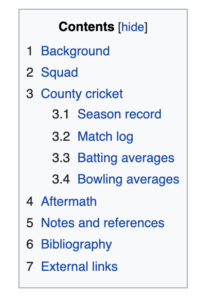So, you have your eye on a few Wikipedia pages and you are determined to make them the best Wikipedia pages in existence. This is the kind of goal that we can really get behind.

What does this require from you, though? Expert knowledge? Impeccable writing skills? Millions of dollars in bribe money?
The answer is, yes (except for the bribe money), and also a friendly warning that that’s just the beginning. If you truly want these pages to be marked as some of the best, you need to familiarize yourself with Wikipedia’s criteria and be prepared to keep an eye on the pages for all eternity.
Table of Contents

This is because anyone can edit a Wikipedia page at any time. Most editors are well-meaning, but even someone with the best of intentions could add an edit that needs some clean-up. This could be because the edit uses improper grammar, isn’t sourced, or isn’t written using neutral language.
Then, of course, there’s the chance of a malicious editor targeting a page. This could result in a page being edited with biased copy, or even nonsensical copy. Obviously this info needs to go as quickly as possible.
For great content that doesn’t need to be removed, you’ll want to focus on these four best practices:
1. Comprehensive
Wikipedia defines this as a page that “neglects no major facts or details, and places the subject in context.” Notice that it says “major” facts or details. This means that a page shouldn’t contain every single detail about a certain subject. These are encyclopedia articles, not in-depth research studies or biographies.
We’re also going to add in that all this information needs to be comprehensible – as in, easy to understand. This means that all content should be well-written, using all the grammar and prose rules you learned in school. This includes using paragraphs, and structuring content so that it flows well – rather than treating every sentence as if it stands alone. Pretend that anything you write is going to be graded or is up for publication in a national newspaper and you should do alright here.
2. Well-Researched

Any content added to a page should be able to withstand the toughest scrutiny. On a basic level, this requires all claims to be verifiable against sources of the highest quality and reliability. It also means that you should be reading as much as possible about the subject, thoroughly familiarizing yourself with the facts. For example, does one source say a company was founded in 1990 and another says 1991? Rather than just picking a year, you need to research more and find out which date is accurate.
You also need to remain up-to-date with the subject in order to keep the page up-to-date. While a Wikipedia page isn’t a news article and shouldn’t include every single tidbit about the subject, it should be updated as time passes. Perhaps a page for a nonprofit included information that the organization was going to expand into new areas of research in January 2021. Once that date has come and gone, take a look around and see if there are reliable sources that expand upon that claim.
3. Neutral
Even if you don’t know anything else about Wikipedia, you might know that it is supposed to be bias-free. After all, it is an encyclopedia, which means its job is to stand as a report of facts, not opinions.
All content needs to be neutral in tone. Deviating from this requirement is a quick way to get a page slapped with a tag. Tags are featured prominently at the top of articles and tell everyone that the page is potentially untrustworthy.
4. Well-Organized
Nothing is worse than a long article that goes on and on and on without any organization. No one wants to look at that. No one.

Long articles should include a lead section and section headings.
- Lead section: this is the very first section on a page. It should summarize the page’s content, giving readers an understanding of what the rest of the article shares in fuller detail.
- Section headings: these headings break up the text and keep it organized. You can think of them like chapter titles in a book, and they make up the page’s Table of Contents.

Shorter articles, known as stubs, might not have enough content for either a lead section or section headings, but don’t dismiss the possibility just because an article is short. Even if a page only consists of two paragraphs, what are the subjects of those paragraphs? Does one focus on history and the other on something else, perhaps a well-known event or service? If so, this would be an ideal place for a section heading.
5. Great Content is Here to Stay
There you have it. If you want your article to stand out for all the right reasons, pay attention to these four best practices and you’ll be well on your way to earning all the (private) fame and glory that your heart desires. You might even one day create an article that winds up on the lists of Good and Featured articles.
If you need some additional help navigating the often complex and confusing world of Wikipedia, we’re ready to answer all your questions. We’re firm believers that the more information you have, the better – especially when it comes to the world’s largest online encyclopedia.



